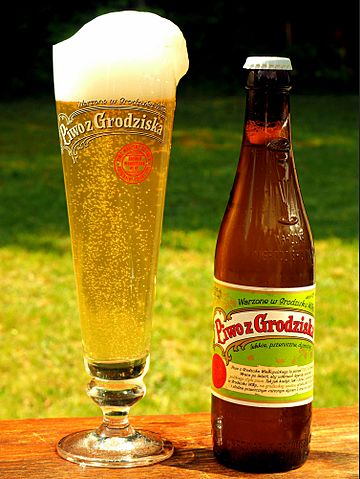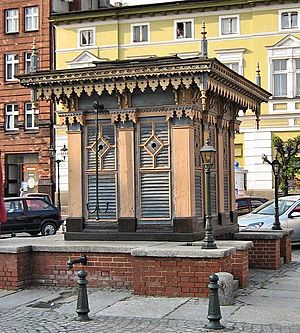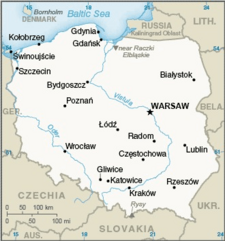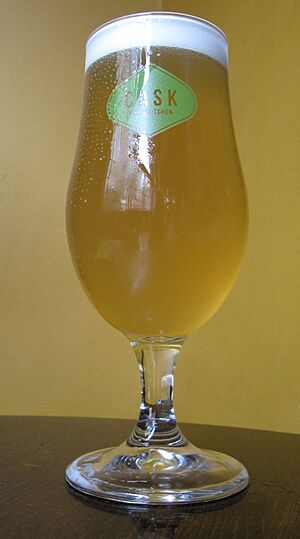Grodziskie facts for kids
Quick facts for kids Grodziskie |
|
|---|---|

Piwo z Grodziska, a modern Polish recreation of Grodziskie, brewed in Grodzisk Wielkopolski, served in a tall conical glass designed for this style of beer
|
|
| Country of origin | Poland |
| Yeast type | Top-fermenting |
| Alcohol by volume | 2.5% – 5% |
Grodziskie (pronounced gro-JIS-kee) is a special kind of beer from Poland. It's made using wheat that has been dried with oak smoke. This gives it a unique, smoky taste and smell.
This beer has a clear, light golden color and lots of bubbles, like Champagne. People even called it "Polish Champagne"! It has a low amount of alcohol and a light, crisp taste. The main flavors come from the smoked wheat, the special water used, and the yeast that helps it ferment.
Grodziskie was first made in the town of Grodzisk Wielkopolski a long time ago, in the 1300s or 1400s. Brewers there had strict rules to make sure it was always good quality. Because of this, it became very famous and was sent to many countries.
After World War II, the way beer was made in Poland changed, and Grodziskie became less popular. By 1993, the last brewery making it closed down. But recently, people who love making beer at home and some breweries have started making Grodziskie again!
Contents
What is Grodziskie Beer Like?
Grodziskie is a beer with lots of bubbles and a low alcohol level. It looks clear and can be pale yellow to golden. It has a smoky smell and taste. Because it's so clear and bubbly, it's often compared to Champagne and is sometimes called "Polish Champagne."
Most beers made from wheat look cloudy. This is because tiny bits of yeast and proteins from the wheat stay in the beer. But Grodziskie is different! It's filtered before it's put into bottles, usually by adding something called isinglass. This filtering takes out the yeast and proteins, making the beer bright and clear.
When you pour Grodziskie into a glass, it makes a big, long-lasting foam with small bubbles. Traditionally, it was served in tall, cone-shaped glasses. These glasses were perfect for showing off its clear, golden color and the thick foam.
The taste is light and refreshing, with a little tingle from all the bubbles. Old notes from 1914 said Grodziskie was "rough" and "bitter" with a strong smoke and hop flavor. But over time, the taste probably changed to be less bitter. Today, Grodziskie often has a smoky flavor from the oak-smoked wheat. Some of its unique taste also comes from how it's made and the special yeast used. You might also notice a mild, grainy taste from the wheat.
Historically, Grodziskie usually had about 3.1% alcohol. But some versions had between 2.5% and 5% alcohol.
What is Grodziskie Made From?
Grodziskie is made mostly from malted wheat. This wheat is dried in special ovens called kilns. These kilns are heated by burning oak wood. Instead of just heating clean air, the hot smoke from the burning oak goes right through the wheat grains. This dries the wheat and gives it a light color and a strong, pleasant smoky flavor.
This special drying process wouldn't work with old kilns that burned coal or coke. The smoke from those fuels would make the wheat discolored and give it a harsh taste. The smoke from the oak also adds chemicals that help keep the beer fresh for a long time, even though it has low alcohol. There's a story that some Grodziskie beer was found buried in North Africa after World War II and was still fresh!
While it was mostly made from wheat, sometimes barley was also used. But for most of its history, it was all wheat.
Special Water for Brewing
A lot of Grodziskie's flavor comes from the special water used to make it. The water from a well in Grodzisk had high levels of minerals like sulfate, chloride, and magnesium.
This type of water can make the hop flavor stronger than expected. It also affects the pH level during brewing, which can make the beer have more unfermented sugars and a lower alcohol content. The high magnesium in the water might also add a slightly sour or bitter taste to the beer.
Unique Yeast Strains
Traditionally, two special types of yeast were used for Grodziskie. One yeast worked fast in the first few days, and the other worked slower, finishing the beer in the tanks and bottles.
Sadly, one of these original yeast types was lost a long time ago. After World War II, yeast was brought in from another brewery, but it wasn't as good and sometimes caused problems. Later, a state-owned brewery found good yeast strains again, but only one of the original types has been kept. Today, most modern Grodziskie beers use common ale yeasts that don't add much yeast flavor.
Hops Used in Grodziskie
Brewers usually used local Polish hops, like Nowotomyski. Sometimes they used similar "noble hops" from other places. In the late 1800s, they used about 3 kilograms (6.6 pounds) of hops for every 100 kilograms (220 pounds) of wheat malt. By the 1960s, they used a bit less.
How Grodziskie is Made
Grodziskie was made using different methods, including infusion mash or decoction mash. Old records from the Grodzisk brewery tell us some of the traditional steps.
The process involved heating the mixture of grain and water (called a mash) at different temperatures for specific times. For example, it was held at 38°C (100°F) for 30 minutes, then at 52°C (126°F) for 30-60 minutes, and so on. After this, the liquid (called wort) was boiled for 90 to 120 minutes. Most of the hops were added early in the boil, and the rest were added closer to the end.
After boiling, the wort was cooled and then fermented in open wooden tanks at 14-16°C (57-61°F). Both types of yeast were added at the same time, and fermentation happened quickly. After one day, the thick foam on top was removed. After 60 hours, about half of the sugars would be fermented, and thick clumps of yeast were collected to be used again.
The beer was then moved to tanks to be clarified. Isinglass was added to make it clear, and then it was put into bottles.
After bottling, the beers were stored for three to five weeks in a dark room at 14-18°C (57-64°F). During this time, the yeast kept fermenting the remaining sugars in the bottles. The carbon dioxide gas produced stayed trapped inside, making the beer very bubbly. Because of all the pressure, about 4-5% of the bottles would burst!
History of Grodziskie Beer
The town of Grodzisk Wielkopolski was first mentioned around 1257. It became important because it was on a trade road. By the 1500s, a family called Ostroróg controlled the town. They supported the Protestant Reformation, and Grodzisk became a center for new ideas and attracted skilled workers and thinkers. Large-scale beer making started when Johann Volanus brought in expert brewers from other regions.
The Legend of Bernard's Well
There's a famous story about Grodziskie beer and a monk named Bernard of Wąbrzeźno. Around 1603, he came to Grodzisk and found the people hungry and the wells dry. The brewery was very important for the town's money. Bernard prayed for the wells, and suddenly, a new source of water filled the Old Market well!
People believed this new water could make them healthy and that the beer made from it was much better than before. The well became very important to the town. For over 200 years, the people of Grodzisk would bring a barrel of their beer from this well to Bernard's monastery every year to say thank you.

Brewing Guilds and Quality Control
In 1601, a guild (a group of skilled workers) for maltsters and brewers was formed in Grodzisk. This guild made sure only certain families could make malt and beer for sale. They also made strict rules to keep the beer's quality high and protect its good name.
There was a special system to check the beer's quality. The mayor and a group of elders would taste each barrel. They would approve it for sale or export with a special stamp. If a brewer tried to cheat, they would lose their right to make beer forever.
At first, all the main breweries shared the Old Market well. But in the mid-1800s, some private breweries dug their own wells and found the water was just as good. Eventually, all breweries built their own wells.
Grodziskie's Growing Fame
The first records of Grodziskie being sent to other places are from 1671. It was so valued that in 1694, the city of Poznań bought it as gifts for important people. It cost 15 guilders per barrel, which was much more expensive than local beer (5-6 guilders). By the 1700s, Grodziskie was known all over Poland and was one of the most expensive beers in the country.
Between 1793 and 1918, when Grodzisk was part of Prussia, the town was renamed Grätz, and the beer became known as Grätzer. During this time, about 3,200 barrels were made each year. Most of it was sent to other towns and cities. By the late 1800s, German immigrants built modern breweries in Grätz. The five breweries there made over 100,000 hectoliters (about 85,000 US beer barrels) of beer, with Grätzer being the most common. It was sent to many parts of Europe and the world. Its popularity was highest just before World War II, when it was exported to 37 countries!
Decline and Revival
After 1922, only one company, Zjednoczone Browary Grodziskie (United Grodzisk Breweries), continued to make Grodziskie. Between 1929 and 1993, the Polish government protected the name of this beer for the region. Production even continued when Germany occupied Poland during World War II.
After the war, the breweries were taken over by the government. Grodziskie started to decline because the government focused on making basic products, and local traditions were not supported. It was hard for brewers to make money from small, high-quality foods.
After the Communist period ended in 1989, a private company tried to continue making Grodziskie. But in 1993, the brewery closed because it wasn't making enough money and it was hard to find workers who knew how to make this special beer. For several years, Grodziskie was not made by any commercial breweries.
However, since 2010, some breweries have started making Grodziskie again for certain seasons or for a limited time. This was helped by homebrewers (people who make beer at home) in Poland and around the world who kept the tradition alive. In 2011, the Polish Homebrewers Association even created a group to help bring Grodziskie beer back.
See also
 In Spanish: Grodziskie para niños
In Spanish: Grodziskie para niños




